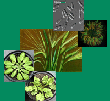| Seyoum, Y; Fetene, P; Strobl, S; Beck, E: Daily and seasonal courses of gas exchange and niche partitioning among coexisting tree species in a tropical montane forest., Flora, 209, 191-200 (2014), doi:https://doi.org/10.1016/j.flora.2014.02.005 | |
| Abstract: We investigated the seasonal gas exchange patterns of three different functional types of tropical afromontane trees, namely Podocarpus falcatus (Thunb.) Mirb. (evergreen gymnosperm), Prunus africana (Hook. f.) Kalkm. (broad-leaf evergreen), and Croton macrostachyus Hochst. ex Del. (broad-leaf deciduous) which grow side-by-side in the Munessa forest, southern Central Ethiopia. The hypothesis is that the trees can make different use of the environmental conditions which change seasonally and also from year to year. These changes can be understood as fluctuating niches, the utilization of which allows coexistence through balanced carbon gain. In this study, light and moisture were considered the two main fluctuating niches. Porometry was used to measure the daily and seasonal responses of the leaves to environmental variables under dry and wet season conditions in the course of the climatically differing years 2009 and 2010. Correlations of the patterns of these responses were analyzed by regression analysis. From daily integrated rates of irradiation, photosynthesis and transpiration, light and water use efficiencies of photosynthetic carbon gain and their mutual interdependences were determined. Except an extended dry season in 2009 when C. macrostachyus had shed its foliage, all three species continued photosynthetic net CO2 uptake concomitant with transpiration at all seasons, although at varying rates. Ecophysiological performance of P. falcatus leaves is mainly light-driven and responds relatively little to a change in moisture conditions. Its carbon and water relations are striving for stability rather than flexibility. As of a typically subdominant species of the forest, P. africana leaves can efficiently use low light intensities but suffer from photoinhibition at full light. Their performance, showing more dynamic response to the environment than P. falcatus, P. africana appears driven more by moisture than by light. Compared to the two evergreens C. macrostachyus exhibited the highest flexibility in its leaves’ physiological responses to environmental conditions, in particular to the light climate which is additionally potentiated by the fast turnover of its foliage. This species optimizes its carbon gain during the wet season and during the early dry period when cloud cover is minimal. Our findings thus reveal that elasticity of the response to fluctuating environmental conditions is an additional aspect in the assessment of the utilization of temporally fluctuating niches by adult tree individuals. |

